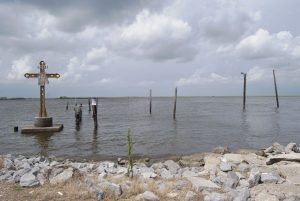Photos Tell a Story of Disappearing Coastal Land
Read the full article online at https://nextcity.org
 “Every hour, a plot of land the size of a football field subsides into the sea in Southeast Louisiana. Over the past 80 years — thanks to the channeling of the Mississippi River, which used to deposit sediment on the shoreline, thanks to drilling for oil and gas, and now rising seas — about 2,000 square miles of the state’s coastal landscape have disappeared. If that boggles the mind, it’s probably also hard to picture. How does a society adapt to the erosion not only of its land mass but also of its traditional means of controlling the environment, its livelihood, its culture? Photographer Virginia Hanusik has been roaming the fingery coastal wetlands of Southeast Louisiana, documenting the impact of rising seas and disappearing wetlands on the small towns there. With an eye for both beauty and irony, she trains her lens on the human interventions in the landscape: the ditches and channels, the cracked fields of concrete, the ubiquitous churches, the houses raised up on stilts.
“Every hour, a plot of land the size of a football field subsides into the sea in Southeast Louisiana. Over the past 80 years — thanks to the channeling of the Mississippi River, which used to deposit sediment on the shoreline, thanks to drilling for oil and gas, and now rising seas — about 2,000 square miles of the state’s coastal landscape have disappeared. If that boggles the mind, it’s probably also hard to picture. How does a society adapt to the erosion not only of its land mass but also of its traditional means of controlling the environment, its livelihood, its culture? Photographer Virginia Hanusik has been roaming the fingery coastal wetlands of Southeast Louisiana, documenting the impact of rising seas and disappearing wetlands on the small towns there. With an eye for both beauty and irony, she trains her lens on the human interventions in the landscape: the ditches and channels, the cracked fields of concrete, the ubiquitous churches, the houses raised up on stilts.
“I’m looking at signs in the landscape, being interested in infrastructure and roads and signage, and seeing the history of those communities through the eyes of the built environment,” says Hanusik. Human influence is largely to blame for the coast’s destruction, and strategies that could slow it are still being debated. In the meantime, Southeast Louisiana residents have to decide whether to hunker down or to pack up and leave. Hanusik visualizes that tension, capturing both abandoned strip malls, and brand-new subdivisions. Hanusik works for an accelerator program that incubates for-profit and nonprofit entities involved in coastal restoration and stormwater management. “Through my work I’m able to understand the high-level issues of land loss and sea level rise and environmental injustice that my photographs have helped me to understand on a smaller scale,” she says. She wants her audience to see this issue from the ground as well. “This is an issue that is only going to become more immediate as more communities around the world are going to start experiencing climate change and rising sea levels and land lock,” she says. “We’re experiencing it here at a really rapid pace, so I think capturing this moment and being able to see the complexities in terms of structural resilience on the ground, that’s kind of my focus.”’
Read the full article online at https://nextcity.org

